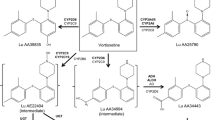Abstract
Bidirectional drug interactions between fluvoxamine and classical antidepressants were studied in depressed patients. A column switching technique combined with high performance liquid chromatography (HPLC) enabled automated analyses of plasma for simultaneous determination of fluvoxamine, tricyclic and tetracyclic antidepressants and demethylated and major hydroxylated metabolites in a single HPLC run. The measurements revealed that fluvoxamine inhibited N-demethylation of imipramine, clomipramine, amitriptyline and maprotiline whereas interferences with hydroxylation reactions were restricted to aromatic 8-hydroxylation of clomipramine. In patients under fluvoxamine monotherapy before comedication, plasma concentrations of fluvoxamine increased after administration of a tricyclic antidepressant, thus indicating bidirectional drug interactions. The inhibitory effects of fluvoxamine on the metabolism of classical antidepressants disappeared after discontinuation of concomitant fluvoxamine treatment within at least 1–2 weeks. The reported alterations in drug metabolism observed in depressed patients who were under fluvoxamine/tricyclic antidepressant comedication suggested that careful supervision and regular drug monitoring are necessary in such patients.
Similar content being viewed by others
References
Aranow RB, Hudson JI, Pope HG jr, Grady TA, Laage TA, Bell IR, Cole JO (1989) Elevated antidepressant plasma levels after addition of fluoxetine. Am J Psychiatry 146:911–913
Ball P, Knuppen R (1980) Catecholestrogens (2- and 4-hydroxyoestrogens): chemistry, biogenesis, metabolism, occurrence and physiological significance. Acta Endocrinol 93 [Suppl 232]:1–127
Bech P (1988) A review of the antidepressant properties of serotonin reuptake inhibitor. Adv Biol Psychiatry 17:58–69
Benfield P, Ward A (1986) Fluvoxamine. A review of its pharmacodynamic and pharmacokinetic properties, and therapeutic efficacy in depressive illness. Drugs 32:313–334
Bertschy G, Vandel S, Vandel B, Allers G, Volmat R (1991) Fluvoxamine-tricyclic antidepressant interaction. An accidental finding. Eur J Clin Pharmacol 40:119–120
Boll E, Tarighati MA, Holsboer F (1986) Clinical application of antidepressant plasma level analysis with high pressure liquid chromatography (HPLC). Pharmacopsychiatry 4:257–258
Brøsen K, Skjelbo E (1991) Fluoxetine and norfluoxetine are potent inhibitors of P450IID6—the source of the sparteine/debrisoquine oxidation polymorphism. Br J Clin Pharmacol 32:136–137
Brøsen K, Otten V, Gram LF (1986) Imipramine demethylation and hydroxylation: impact of the sparteine oxidation phenotype. Clin Pharmacol Ther 40:543–549
Chawla RK, Bonkovsky HL, Galambos JT (1990) Biochemistry and pharmacology of S-adenosyl-l-methionine and rationale for its use in liver disease. Drugs 40 [Suppl 3]:98–110
Claasen V (1983) Review of the animal pharmacology and pharmacokinetics of fluvoxamine. Br J Clin Pharmacol 15:349S-355S
Clarke S, O'Connor CM (1983) Do eukaryotic carboxyl methyltransferases regulate protein function? TIBS 8:391–394
Cooper GL (1988) The safety of fluoxetine — an update. Br J Psychiatry 153 [Suppl 3]:77–86
Dechant KL, Clissold SP (1991) Paroxetine. A review of its pharmacodynamic and pharmacokinetic properties, and therapeutic potential in depressive illness. Drugs 41:225–253
Fritze, J, Unsorg B, Lanczik M (1991) Interaction between carbamazepine and fluvoxamine. Acta Psychiatr Scand 84:583–584
Goff DC, Midha KK, Brotman AW, Waites M, Baldessarini RJ (1991) Elevation of plasma concentrations of haloperidol after the addition of fluoxetine. Am J Psychiatry 148:790–792
Gram LF, Brøsen K, Christensen P, Kragh-Sorensen P (1987) Pharmacokinetic considerations relevant to the pharmacodynamics of antidepressants. In: Dahl SG, Gram LF, Paul SM, Potter WZ (eds) Clinical pharmacology in psychiatry. Selectivity in psychotropic drug action-promises or problems? Psychopharmacology Series 3. Springer, Berlin Heidelberg New York, pp 184–192
Härtter S, Wetzel, H, Hiemke C (1992) Automated determination of fluvoxamine in human plasma by column switching-high performance liquid chromatography. Clin Chem (in press)
Henderson JF, Mazel P (1964) Studies of the induction of microsomal S-, N- and O-demethylases. Biochem Pharmacol 13:1471–1474
Krüger R, Hölzl G, Kuss HJ, Schefold L (1986) Comparison of the metabolism of the three antidepressants amitriptyline, imipramine, and chlorimipramine in vitro in rat liver microsomes. Psychopharmacology 88:505–513
Milne RJ, Goa KL (1991) Citalopram. A review of its pharmacodynamic and pharmacokinetic properties, and therapeutic potential in depressive illness. Drugs 41:450–477
Nelson JC, Mazure CM, Bowers MB, Jatlow PI (1991) A preliminary, open study of the combination of fluoxetine and desipramine for rapid treatment of major depression. Arch Gen Psychiatry 48:303–307
Potter WZ, Rudorfer MV, Maji H (1991) The pharmacologic treatment of depression. N Engl J Med 325:633–642
Rickels K, Schweizer E (1990) Clinical overview of serotonin reuptake inhibitors. J Clin Psychiatry 51 [Suppl B]:9–12
Rosenstein DL, Takeshita J, Nelson JC (1991) Fluoxetine-induced elevation and prolongation of tricyclic levels in overdose. Am J Psychiatry 148:807
Schatzberg AF, Dessain E, O'Neil P, Katz DL, Cole JO (1987) Recent studies on selective serotonergic antidepressants: trazodone, fluoxetine,/and fluvoxamine, J Clin Psychopharmacol 7:44S-49S
Schneider LS, Cooper TB, Severson JA, Zemplenyi T, Sloane RB (1988) Electrocardiographic changes with nortriptyline and 10-hydroxynortriptyline in elderly depressed outpatients. J Clin Psychopharmacol 8:402–408
Sjöqvist F, Bertilsson L (1984) Clinical pharmacology of antidepressant drugs: pharmacogenetics. In: Usdin E et al (eds) Frontiers in biochemical and pharmacological research in depression. Raven Press, New York, pp 359–371
Vance DE, de Kuijff B (1980) The possible functional significance of phosphatidylethanolamine methylation. Nature 288:277–279
Vandel S, Bouquet S, Bonin B, Bertschy G, Baumann P (1991) Pharmacokinetics of antidepressants: fluoxetine and fluvoxamine in daily clinical practice. In: Racagni G et al (eds) Biological psychiatry. Elsevier Amsterdam, pp 368–371
Vaughan DA (1988) Interaction of fluoxetine with tricyclic antidepressant (letter). Am J Psychiatry 145:1478
Author information
Authors and Affiliations
Additional information
This work contains results of the PhD-thesis of S. Härtter
Rights and permissions
About this article
Cite this article
Härtter, S., Wetzel, H., Hammes, E. et al. Inhibition of antidepressant demethylation and hydroxylation by fluvoxamine in depressed patients. Psychopharmacology 110, 302–308 (1993). https://doi.org/10.1007/BF02251285
Received:
Revised:
Issue Date:
DOI: https://doi.org/10.1007/BF02251285



